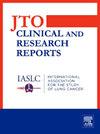First-line Selpercatinib or Chemotherapy and Pembrolizumab in Patients From East Asia With RET Fusion–Positive NSCLC: A LIBRETTO-431 Subgroup Analysis
IF 3.5
Q2 ONCOLOGY
引用次数: 0
Abstract
Introduction
Selpercatinib’s consistent efficacy and manageable safety profile were observed in patients with RET fusion–positive NSCLC across geographies in single-arm studies (LIBRETTO-001 and LIBRETTO-321). Here, we report the efficacy and safety of the phase 3 study LIBRETTO-431 in patients from East Asia.
Methods
LIBRETTO-431 (NCT04194944) is a randomized, open-label phase 3 trial comparing first-line selpercatinib versus pemetrexed and platinum with or without pembrolizumab. Geography (East Asia versus non-East Asia) was a stratification factor. Efficacy end points including progression-free survival (PFS), objective response rate, and duration of response as assessed by means of blinded independent central review were evaluated in patients from East Asia. Pharmacokinetics were assessed in the selpercatinib group. Safety data were collected for all patients who received at least one dose of study treatment.
Results
Of the 261 patients enrolled, 142 (54.4%) were from East Asia, with 116 randomized to the intention-to-treat-pembrolizumab population (selpercatinib: n = 75, control: n = 41). With a median follow-up of 19.4 and 21.2 months in the selpercatinib and control groups respectively, the median PFS in patients from East Asia was not yet reached for selpercatinib (95% confidence interval (CI): 16.4–not evaluable) versus 11.1 months (95% CI: 7.0–16.8) for control (hazard ratio: 0.38 [95%CI: 0.22–0.68]; p = 0.0008). Safety and pharmacokinetics were consistent with those previously reported across the development program and adverse events were generally manageable with dose adjustments.
Conclusions
Consistent with results in the overall LIBRETTO-431 population, selpercatinib exhibited superior PFS compared with chemotherapy plus pembrolizumab in patients from East Asia with a manageable safety profile. These data further highlight the importance of early comprehensive genomic testing and the use of selpercatinib as a preferred first-line regimen in patients with RET fusion–positive NSCLC across geographies.
东亚RET融合阳性NSCLC患者的一线Selpercatinib或化疗和Pembrolizumab: LIBRETTO-431亚组分析
在单臂研究(LIBRETTO-001和LIBRETTO-321)中,selpercatinib在不同地区的RET融合阳性NSCLC患者中具有一致的疗效和可管理的安全性。在此,我们报告了3期研究LIBRETTO-431在东亚患者中的有效性和安全性。方法:slibretto -431 (NCT04194944)是一项随机、开放标签的3期试验,比较了一线selpercatinib与培美曲塞和铂在使用或不使用派姆单抗时的疗效。地理(东亚与非东亚)是一个分层因素。疗效终点包括无进展生存期(PFS)、客观缓解率和持续时间,通过盲法独立中心评价在东亚患者中进行评估。观察自泊替尼组的药代动力学。收集了所有接受至少一剂研究治疗的患者的安全性数据。在纳入的261例患者中,142例(54.4%)来自东亚,其中116例随机分配到意向治疗派姆单抗人群(selpercatinib: n = 75,对照组:n = 41)。selpercatinib组和对照组的中位随访时间分别为19.4和21.2个月,selpercatinib组东亚患者的中位PFS尚未达到(95%置信区间(CI): 16.4 -不可评估),而对照组的中位PFS为11.1个月(95% CI: 7.0-16.8)(风险比:0.38 [95%CI: 0.22-0.68]; p = 0.0008)。安全性和药代动力学与先前在整个开发项目中报道的一致,不良事件通常可以通过剂量调整来控制。与LIBRETTO-431总体人群的结果一致,selpercatinib在东亚患者中与化疗加派姆单抗相比表现出更高的PFS,并且具有可控的安全性。这些数据进一步强调了早期全面基因组检测的重要性,以及将selpercatinib作为RET融合阳性NSCLC患者首选一线治疗方案的重要性。
本文章由计算机程序翻译,如有差异,请以英文原文为准。
求助全文
约1分钟内获得全文
求助全文
来源期刊

JTO Clinical and Research Reports
Medicine-Oncology
CiteScore
4.20
自引率
0.00%
发文量
145
审稿时长
19 weeks
 求助内容:
求助内容: 应助结果提醒方式:
应助结果提醒方式:


